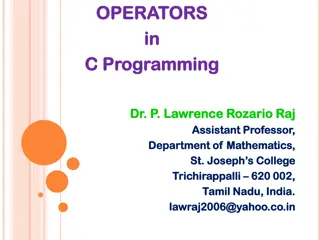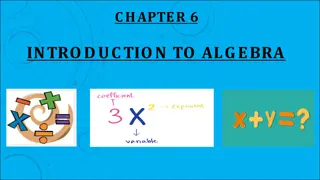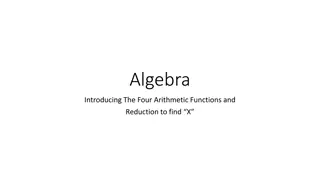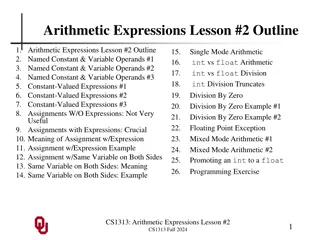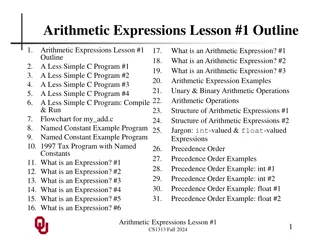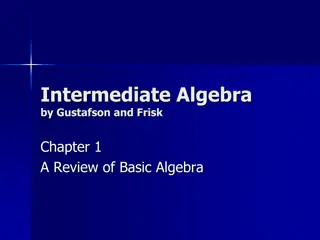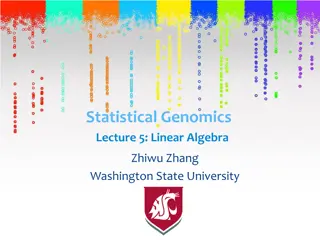Complex Variables: Introduction to Arithmetic and Algebra
Complex variables play a crucial role in physics and engineering, offering a powerful tool for analysis and problem-solving. This content explores the basics of complex arithmetic and algebra, including operations like addition, subtraction, multiplication, and division. Understanding complex numbers as ordered pairs of real numbers, along with their geometric interpretation, is vital for mastering applications in fields like phasor-domain analysis, conformal mapping, and more.
Download Presentation

Please find below an Image/Link to download the presentation.
The content on the website is provided AS IS for your information and personal use only. It may not be sold, licensed, or shared on other websites without obtaining consent from the author.If you encounter any issues during the download, it is possible that the publisher has removed the file from their server.
You are allowed to download the files provided on this website for personal or commercial use, subject to the condition that they are used lawfully. All files are the property of their respective owners.
The content on the website is provided AS IS for your information and personal use only. It may not be sold, licensed, or shared on other websites without obtaining consent from the author.
E N D
Presentation Transcript
ECE 6382 Fall 2023 David R. Jackson Notes 1 Introduction to Complex Variables Notes are adapted from D. R. Wilton, Dept. of ECE 1
Some Applications of Complex Variables Phasor-domain analysis in physics and engineering Laplace and Fourier transforms Series expansions (Taylor, Laurent) Evaluation of integrals Asymptotics (method of steepest descent) Conformal Mapping (solution of Laplace s equation) Radiation physics (branch cuts, poles) 2
Complex Arithmetic and Algebra A complex number z may be thought of simply as an ordered pair of real numbers (x, y) with rules for addition, multiplication, etc. ( ) ( ) = + = = = = = ( ) 1, R e , z Im , z x iy i j x y z z x y ( ) = + cos sin r re i (from figure) z plane z r = i (Euler formula (not yet proven!)) z ( ) z arg y r Note: In Euler's formula, the angle must be in radians. x Note: But we need to be careful to properly interpret the square root (using the principal branch). This is what the radical sign usually denotes. We can say that i = Argand diagram (polar form) 1 Note: Usually we will use i to denote the square root of -1. However, we will often switch to using j when we are doing an engineering example. 3
Complex Arithmetic and Algebra Note on phase angle (argument): The phase angle is non-unique. We can add any multiple of 2 (360o) to it. This does not change x and y. z plane z y r Principal branch: The most common choice for the principal branch is*: x Note: = + Adding multiples of 2 to will affect some functions, but not others. 2 n p p ( ) f z ( ) f z ( ) Examples: = z noeffect ( willeffect ) = 1/2 z *e.g., the one that Matlab uses 4
Complex Arithmetic and Algebra (cont.) Addition/ subtraction: ( ( ) ) ( i y ) ) = + + + z z x iy x iy 1 2 1 1 2 2 ( x x y 1 2 1 2 Geometrically, this works the same way and adding and subtracting two-dimensional vectors: Note: z1 z2 has a vector direction that points from z2 to z1. + z z 1 2 y y 1z 1z tip-to-tail rule 2z 2z z z 1 2 x x 2z 5
Complex Arithmetic and Algebra (cont.) Multiplication: ( )( ) = + + + z z x iy x iy 1 2 1 1 y y 2 2 ( ) ( ) + ( )( ) 1 2 x x i x y x y = + + = 2 Example: 0 1 0 i 1 i 1 i 1 2 1 2 2 1 ( )( ) ( ) + i i i = = z z re r e 1 2 rr e 1 2 1 2 1 2 1 2 Division: = 1 + + x x x x iy iy + x x + iy iy = / z z 1 1 2 2 1 2 2 2 y y 2 2 + + + ( ) i y x y + ) y 2 1 x 1 2 x x x y y y 1 2 y x x y y x = = / , z z 1 2 1 2 x 1 2 2 2 1 2 2 2 2 1 1 2 2 2 2 2 2 2 2 2 r r ( ) ( / ( ) i i i = = / z z re r e e 1 1 2 1 2 1 2 1 2 = 2 Example: 1/i i Multiplication and division are easier in polar form! 6
Complex Arithmetic and Algebra (cont.) Important point: We can multiply and divide complex numbers. We cannot divide two-dimensional vectors. (We can, however, multiply two-dimensional vectors in two different ways, using the dot product and the cross product.) 7
Complex Arithmetic and Algebra (cont.) y Conjugation: z ( ) x iy * r z x Magnitude: r = * z z z *z To see this: ( )( ) = = + = x iy + x iy = 2 2 * z r x y z z or ( )( ) i i = = = * z r re re z z 8
Eulers Formula Recall: 2 3 n x x x n = + + + + = x 1 e x 2! 3! ! = 0 n = x iy + Define extension to a complex variable ( ): x z 2 3 n z z z n + + + + = z (converges for all ) 1 e z z Leonhard Euler 2! 3! ! = 0 n ( ) i n n 2 4 3 5 i = = + + + 1 e i ! 2! 4! 3! 5! = 0 n = + cos sin i Note: The variable here is usually taken to be real, but it does not have to be. i i = + = cos sin cos sin e i e i Also : More generally, = + = z i iz iz cos sin cos sin e z i z e z + iz iz iz iz e e e e i z = = cos sin z z 2 e 2 e z z z z z + e e i e e ( ) iz ( ) iz = = = = = cos cosh , sin z sinh i i z 2 2 2 9
Application to Trigonometric Identities Many trigonometric identities follow from a simple application of Euler's formula: = + 2 i cos2 sin2 e i On the other hand, ( ) 2 ( ) ( ) 2 i = = + = + 2cos sin 2 2 2 i cos sin cos sin e e i i identities: two Equating real and imaginary parts of t he two expressions yields = = 2 2 cos2 sin2 cos 2cos sin sin ( ) ( ) ( ) i = + cos sin e i 1 2 1 2 1 2 On the other hand, ( ) i i i = = = e e e 1 2 1 2 ( ( )( sin ) + cos sin cos sin + i i 1 1 2 2 sin ( ) ) cos cos sin cos cos sin i 1 2 1 2 1 2 1 2 Equating real and imaginary parts yields: ( ( ) ) = = cos cos cos sin sin 1 2 1 2 1 2 sin sin cos cos sin 1 2 1 2 1 2 10
DeMoivres Theorem ( ) n ( ) i n n in r e n = = = + (DeMoivre's Theorem) cos sin z re r n i n independent Note that for an integer, the result is of how is measured n n ( ) ( ) = ( ) ( ) + + 2 2 i k i n kn ) n n = = + + + ( an int ge e r) cos 2 sin 2 p p re r e r n kn i n kn k p p ( n + cos sin r n i n p p n = z y z z x + 2 2 Abraham de Moivre 11
Roots of a Complex Number 1 n = w z In this case the results depend on how is measured. roots n ( ) 1 n ( ) + k n ) ( 2 p i 1 n 1 n 1 n + + + 2 i k n 2 2 k k = = = + = cos sin , 0,1,2, 1 z re r e r i k n p p n n n n E xamp e: l 1 3 2 k 2 2 k k + 1 3 + 2 i i i i k + + ( ) = = = + = 6 3 2 8 8 2 2 cos sin , 0,1,2 i e e i k 6 3 6 3 = 3 1 2 1 3 ( ) ( ) ( ) = = + = + = 2 cos 0: 8 2 cos sin 30 sin 30 2 3 , k i i i i i 6 6 2 2 2 1 3 ( ) ( ) ( ) = = + + + = + = 2 cos 90 1: 8 2 cos sin sin 90 2 , i k i i i 6 3 6 3 4 4 1 3 ( ) ( ) ( ) = = + + + = + = 2 cos 210 2: 8 2 cos sin sin 210 3 , k i i i i 6 3 6 3 12
Roots of a Complex Number (cont.) )1/3 y ( 1/3 z = = 8 w i v Example (cont.) z w w u iv = + 3 2 , , i x u 1 3 ( ) = 8 i i 8i 3 i Im 1 120 Note that the th root of can also be expressed in terms of the : th root of unity n z 1 0 n Re 1 n ( ) + k n 2 i p 1 n 1 n 1 n + Cube root of unity (n = 3) 2 i k kn n 2 i i p = = = p z re r e r e e n 1 240 "principal branch" 2 k n th root f unity n o 2 ( ) 1 n k 1 n kn ( ) 1 th root of unity 2 i 2 i k = = + = where cos sin , 0,1, , 1 e e i k n n n 13




